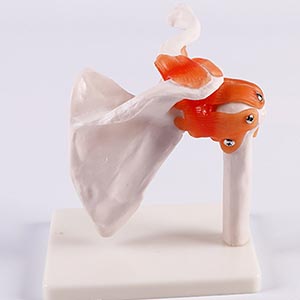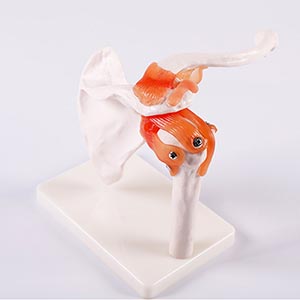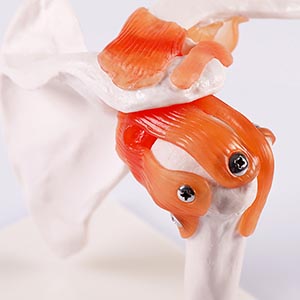Welcome to visitShanghai Chinon medical Model & Equipment Manufacturing Co., LTD
The shoulder joint, as one of the most flexible joints in the human body, has many types of diseases and injuries due to its anatomical complexity and diversity of functions. Clinically, shoulder dislocation, rotator cuff injury, shoulder periarthritis and other diseases require medical personnel to have accurate anatomical and operational skills. In this context, can the shoulder joint model, as a simulation training tool, provide more accurate clinical training? This paper will discuss the contribution of shoulder joint model to precise clinical simulation training from the aspects of clinical significance, model function, data support and future development direction.
1. Clinical significance of shoulder joint model in precision training

The shoulder joint involves a number of anatomical structures, including acromioclavicular joint, scapular joint, humerus head, rotator cuff muscle group, etc. The functions of these structures are closely related, and any injury may lead to joint dysfunction. In clinical practice, surgeons, physiotherapists and other medical personnel need to have a deep understanding of the anatomy and biomechanics of the shoulder joint to ensure that unnecessary complications are avoided during treatment.
Traditional clinical practice and anatomy learning often rely on live anatomical specimens, two-dimensional images, or video explanations. However, these methods have certain limitations, especially when practicing delicate clinical procedures. The shoulder joint model provides an efficient and safe training platform that enables participants to perform repeated exercises in a simulated environment to improve their skills and confidence. The accuracy of this model ensures that participants can avoid errors in the actual clinic and reduce risks to patients.
Clinical application: Treatment of shoulder dislocation
For example, in the treatment of a dislocated shoulder, the surgeon needs to reduce the shoulder joint with precision and avoid further damage to the rotator cuff muscle or shoulder capsule. The shoulder joint model provides a detailed anatomical structure and reduction path, allowing physicians to train their manipulation skills in a simulated environment, thereby improving treatment success and reducing clinical manipulation errors.
2. How can the shoulder joint model improve training accuracy

The design of the shoulder joint model is often highly reflective of the real anatomy, including detailed descriptions of the joint soft tissues, ligaments, muscles, and joint cavities, making it an ideal tool for accurately simulating clinical operations.
2.1 Interactive and multi-dimensional training
Modern shoulder joint models are often highly interactive, allowing students to perform a variety of clinical procedures such as shoulder examinations, injections, and joint dislocation reduction. These models can be used over and over again, allowing students to personalize training to their needs at different stages of the learning process. For example, students can practice the shoulder joint injection technique repeatedly on the model, learning how to accurately select the injection site and judge the depth and direction of the injection.
In addition, some advanced shoulder models are equipped with sensors and feedback systems that provide immediate feedback as students operate them. This feedback can help students correct wrong actions and master more precise operating skills.
2.2 Reduce operational errors and clinical risks
Through the training of the shoulder joint model, students can practice various surgical and therapeutic operations without the risk of patients, thereby reducing operational errors in the actual clinic. Especially in complex shoulder surgery, doctors often need to be very precise to avoid damaging the nerves, blood vessels and soft tissues around the joint. The shoulder joint model is able to simulate these complex physiological conditions, so that students can repeatedly practice in a risk-free environment, and ultimately improve the success rate of surgery.
3. Data support: Effectiveness of shoulder joint model in clinical simulation training

In recent years, the research on the effectiveness of shoulder joint model in clinical simulation training is increasing gradually. Research data show that the shoulder joint model can significantly improve the patient's operational accuracy and clinical performance.
3.1 Case study: Shoulder joint surgery skills training
A study of 200 medical students showed that students trained with the shoulder joint model had a 35 percent reduction in errors during subsequent shoulder joint procedures. These students were able to deal with joint injuries more precisely during surgery, avoiding common technical errors such as humerus head injuries and shoulder dislocation. The study showed that the use of the shoulder joint model at the basic training stage can help students better understand the structure and function of the shoulder joint, and apply the skills learned in actual surgery.
3.2 Study data: Shoulder injection skills training
Another study on shoulder injection skills showed that physical therapists trained using a shoulder joint model improved their injection accuracy by 28 percent. These physiotherapists are able to more accurately select the injection point and Angle when performing shoulder injections in the clinic, thereby improving patient outcomes and reducing complications.
4 Conclusion: The importance of shoulder joint model in clinical simulation training
The shoulder joint model is a key tool for improving clinical skill training by providing accurate anatomical structure, interactive training platform and real-time feedback mechanism. Whether in the shoulder joint reduction, injection operation or complex surgical training, the shoulder joint model can provide a safe, efficient and risk-free training environment for medical personnel. Combined with data support, the shoulder joint model can significantly improve the operational accuracy of students, reduce clinical errors, and help students better respond to practical clinical challenges.
With the development of technology, the function of the shoulder joint model will continue to be enhanced, and the future may be combined with virtual reality, augmented reality and other technologies to further enhance the realism and interaction of training. Shoulder models will undoubtedly continue to play a vital role in medical education and clinical skills training.